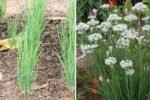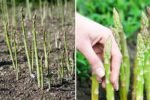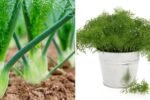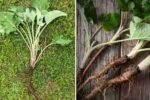Once a staple in classic American pies and jams, rhubarb is making a major comeback. With its striking red stalks and unmistakably tart flavor, rhubarb brings both beauty and boldness to the kitchen. While it’s often thought of as a fruit—thanks to its starring role in sweet desserts—rhubarb is technically a vegetable, and a very nutritious one at that.
From farmers’ markets in the Midwest to farm-to-table restaurants on the coasts, Americans are rediscovering rhubarb’s versatility. It can be used in everything from pies and chutneys to cocktails and salads, bringing a unique tang that wakes up any dish. Beyond its flavor, rhubarb packs a surprising array of health benefits—from digestion support to antioxidant protection—making it one of the most underrated superfoods of the season.
In this guide, we’ll explore everything you need to know about rhubarb—its history, health benefits, cooking ideas, and how to make the most of this colorful springtime gem.
What Is Rhubarb?
Rhubarb (Rheum rhabarbarum) is a perennial vegetable that thrives in cool climates, especially across northern regions of the United States. It’s known for its crimson to pink stalks and large green leaves—though it’s crucial to note that rhubarb leaves are toxic and should never be eaten.
The stalks, however, are safe, edible, and delicious. They have a tart, lemony flavor that pairs beautifully with sweet ingredients like strawberries, apples, and honey.
Rhubarb grows best in spring and early summer, making it one of the first fresh “fruits” to hit the farmers’ market after winter. Its tangy-sweet balance has earned it a loyal following among bakers and chefs alike.
Rhubarb’s Nutritional Profile

Despite its reputation as a dessert ingredient, rhubarb is surprisingly healthy. It’s low in calories, rich in fiber, and provides a good dose of vitamins and minerals.
One cup (about 120 grams) of chopped raw rhubarb contains:
- Calories: 26
- Fiber: 2 grams
- Vitamin K: 45% of the daily recommended intake
- Vitamin C: 16% of the daily recommended intake
- Calcium: 10% of the daily recommended intake
- Potassium: 6% of the daily recommended intake
It also contains antioxidants like anthocyanins and polyphenols, which contribute to its bright red color and anti-inflammatory properties.
Key Health Benefits of Rhubarb
1. Promotes Healthy Digestion
Rhubarb is an excellent source of dietary fiber, which supports gut health and helps prevent constipation. In fact, rhubarb has long been used in traditional medicine as a natural digestive aid.
2. Supports Bone Health
Thanks to its high vitamin K content, rhubarb helps strengthen bones and support calcium absorption—essential for maintaining bone density, especially in older adults.
3. Rich in Antioxidants
The deep red color of rhubarb is more than just eye-catching—it’s a sign of powerful antioxidants. Compounds like anthocyanins and lycopene help protect your cells from oxidative stress, potentially lowering the risk of chronic diseases.
4. Boosts Heart Health
Rhubarb’s fiber and antioxidant content may help reduce cholesterol levels and improve circulation. Studies suggest that regular consumption of high-fiber vegetables can contribute to healthier blood pressure and cholesterol profiles.
5. Supports Weight Management
Low in calories and high in water and fiber, rhubarb makes a great addition to a weight-loss-friendly diet. It fills you up without adding excess sugar or fat.
How to Choose and Store Rhubarb

When shopping for rhubarb at your local farmers’ market or grocery store, look for:
- Color: Bright red or pink stalks (deeper red tends to be sweeter).
- Texture: Firm, crisp, and free of blemishes.
- Leaves: If still attached, they should look fresh and green—but remember, discard them before cooking.
Storage tips:
- Refrigerator: Wrap rhubarb stalks in a damp paper towel and place them in a plastic bag in the crisper drawer. They’ll stay fresh for up to a week.
- Freezer: For longer storage, chop rhubarb into 1-inch pieces, blanch briefly, and freeze in airtight containers. Perfect for pies and sauces later in the year.
How to Prepare Rhubarb
Preparing rhubarb is simple once you know the basics:
- Trim off the leaves and discard them safely.
- Rinse the stalks under cold water to remove any dirt.
- Trim the ends and cut the stalks into your desired size—smaller pieces for sauces or larger chunks for baking.
Raw rhubarb is extremely tart, so it’s typically cooked with sugar or fruit to balance its flavor. However, a few thin slices can add a refreshing tang to salads or salsas.
Delicious Ways to Enjoy Rhubarb

Rhubarb’s tartness opens up a world of creative possibilities in the kitchen. Here are some delicious, American-inspired ways to enjoy it:
1. Classic Strawberry Rhubarb Pie
A timeless favorite that blends tart rhubarb with sweet, juicy strawberries inside a buttery crust. Serve it warm with vanilla ice cream for a nostalgic dessert.
2. Rhubarb Crisp or Crumble
Combine chopped rhubarb with sugar, oats, and cinnamon for an easy dessert that tastes like home. It’s a crowd-pleaser for backyard barbecues or family dinners.
3. Rhubarb Compote
Cook rhubarb down with honey and lemon juice for a tangy compote that pairs perfectly with yogurt, pancakes, or oatmeal.
4. Rhubarb Chutney
Add diced rhubarb to vinegar, ginger, and spices for a savory-sweet chutney that’s amazing with roasted meats, grilled chicken, or cheese boards.
5. Rhubarb Lemonade or Cocktail Syrup
Simmer rhubarb with sugar and water to create a vibrant pink syrup. Mix it into lemonade, sparkling water, or cocktails for a refreshing twist.
6. Rhubarb Muffins or Quick Bread
Add chopped rhubarb to muffin or bread batter for a tangy breakfast treat with a hint of sweetness.
Cooking Tips for Perfect Rhubarb

- Balance the tartness: Rhubarb is naturally sour. Pair it with sweet ingredients like berries, apples, or oranges for balance.
- Sweeten smartly: Instead of refined sugar, try honey, maple syrup, or stevia for a healthier approach.
- Add aromatics: Vanilla, cinnamon, ginger, and nutmeg complement rhubarb beautifully.
- Don’t overcook: Rhubarb softens quickly—cook until tender but not mushy for the best texture.
Rhubarb in American Cuisine
Rhubarb has deep roots in American food culture. In the 19th and early 20th centuries, it was a staple in home gardens and a sign that spring had arrived. Known affectionately as the “pie plant,” rhubarb was especially popular in the Midwest and New England, where it thrived in cooler climates.
Today, rhubarb is enjoying a revival among modern American chefs who love its versatility. You’ll find it in craft cocktails, savory sauces, and trendy desserts across the country. Its natural tartness pairs beautifully with both sweet and savory flavors, making it a favorite ingredient in the growing farm-to-table movement.
Fun Facts About Rhubarb

- Rhubarb is technically a vegetable, but in 1947, the U.S. legally classified it as a fruit for trade purposes due to its culinary uses.
- The word “rhubarb” comes from the Latin rheum barbarum, meaning “foreign root.”
- Minnesota and Washington are among the top rhubarb-producing states in the U.S.
- Rhubarb festivals are held annually in several states, including Minnesota and Maine, celebrating everything from rhubarb pies to rhubarb jams.
Sustainability and Growing Rhubarb at Home
Rhubarb is a hardy, low-maintenance plant that can thrive for years once established. It’s ideal for American home gardens, especially in cooler northern regions.
Tips for growing rhubarb:
- Plant in early spring or late fall in well-drained soil.
- Choose a sunny spot—rhubarb loves full sunlight.
- Don’t harvest in the first year; let the plant grow strong.
- Once established, you can harvest stalks every spring for years.
Growing your own rhubarb not only reduces food miles but also gives you access to fresh, organic stalks for baking and cooking all season long.
Final Thoughts: Why Rhubarb Deserves a Place in Your Kitchen
Vibrant, tangy, and full of health benefits, rhubarb is more than just a pie filling—it’s a symbol of spring, creativity, and flavor. Whether you’re baking a traditional strawberry-rhubarb pie, making a savory chutney, or stirring up a pink rhubarb cocktail, this vegetable brings color and excitement to any table.
As Americans embrace healthier, more local ingredients, rhubarb stands out as a true seasonal star. So next time you see those ruby-red stalks at the market, don’t pass them by—bring them home, get creative, and rediscover one of the most delicious and versatile vegetables nature has to offer.





